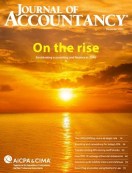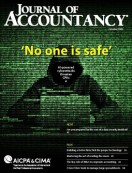- newsletter
- Extra Credit

Help nontraditional accounting students thrive
Follow these tips to make all students more welcome in your classroom.
Please note: This item is from our archives and was published in 2019. It is provided for historical reference. The content may be out of date and links may no longer function.
Related
Secrets of master accounting teachers
Prepare students today for accountants’ shifting roles
Help international students thrive on campus
TOPICS
When she was in her late 20s, Katherine Leahy had an associate’s degree and loved her bookkeeping job, but she was, she recalled, “geeking out about accounting.” So, she enrolled at Hofstra University on Long Island to earn her bachelor’s degree in accounting.
She worked full time while attending evening classes and graduated with a 3.9 GPA and job offers from four of the Big Six accounting firms at the time. Today, she continues to love the field as a CPA and the chief executive officer of 3 Beans for Nonprofits, a Boston-based consultancy specializing in interim CFO assistance and board training.
Leahy’s track made her a nontraditional student, or one who doesn’t graduate from high school and immediately start a four-year degree while relying on their parents. These students are typically older and more likely to have a job, be financially independent, have children, or attend school part time, according to the National Center for Education Statistics. Estimates of total enrollment vary, but research suggests that around four-fifths of today’s students can be considered nontraditional.
At Oakton Community College in Des Plaines, Ill., most of the students accounting professor Leslie Van Wolvelear, CPA, CGMA, teaches are considered nontraditional. “They know that they’re here for a purpose. They’re not in school just because Mom and Dad said they had to be,” she said. “They understand the value of the education.”
These students’ varied backgrounds and life experiences can add diversity of thought and opinion to the classroom, something most faculty consider a plus. But their needs vary from those of an 18-year-old living in the nearby dorm. Consider these approaches when working with nontraditional students:
Get to know them. This segment is more likely to have a story to tell, so ask about it. “I strongly believe in the value of instructors’ getting to know their students,” said Matthew Notbohm, CPA, Ph.D., associate professor of accountancy and director of the Online Master of Accountancy program at the University of North Dakota in Grand Forks. “I believe this is more important with nontraditional students.”
While learning more about these students, you may uncover issues that may affect the learning process, said Lisa Busto, CPA, an assistant professor of accounting at Harper College in Palatine, Ill. Is there a gap between now and when they last attended school, and could this result in a lack of confidence? Or were they in school in a different technological era, and could they use some tech training to get them up to speed?
“It is crucial to understand the concerns and fears of the nontraditional student so the instructor can assist and address them,” she said.
Stress time management skills. Because nontraditional students are more likely to have more time pressures, Van Wolvelear starts every semester with a lesson on time-management skills. She provides an example of how her busy week is structured and asks students to fill in a sample calendar with how time will be spent on duties including families, work, class, reading, and studying. “Start being mindful of structuring your time,” she tells them. “I bring it up every few weeks.”
Be flexible. Given their many commitments, nontraditional students are more likely to need flexibility. “Sometimes conflicts with class meeting times and/or due dates come up very suddenly,” Notbohm said. “These students need a flexible professor who is willing to consider their situation and work with them.”
Van Wolvelear allows students to take the best 10 scores from 12 quizzes, giving them breathing room if they can’t squeeze in studying once or twice. She also allows late homework, albeit with a 10-point score deduction, and offers extra-credit activities to boost grades. She urges students to talk to her if they will have difficulty completing an assignment, but insists that they should also be held accountable. “Be flexible, but also hold students to ownership of their education,” she said.
Let them set the pace. Busto suggested making class materials readily available and allowing students to work ahead when possible. “Students want to manage their own time,” she explained.
When it comes to group work or projects, faculty should be mindful that nontraditional students may not be able to easily meet outside of class, said Notbohm. “Nontraditional students don’t do as well with lots of meetings at specific times,” he pointed out. “If we can let these students complete schoolwork at times that best suit them, then they will perform better.”
Teach problem-solving. Faculty should provide students with real-life problems in addition to purely academic ones to better prepare them for the workplace, said Nieshia M. Gutierrez, CPA, who was a nontraditional student at the University of Colorado in Denver. “The academic setting is the ideal place to learn real-world solutions and make mistakes in a safe environment,” said Gutierrez, assurance manager with DJJCPA LLC in Denver.
Tap into their work experiences. Notbohm recommends that faculty draw upon the valuable work experience that nontraditional scholars are more likely to have. “They are generally happy to relay how their work experience fits with, or doesn’t fit with, the content covered in class,” he said. “It creates a deeper discussion than what I would typically experience with traditional students.”
One positive side to teaching nontraditional students is that they are likely to be able to use what they learn in class immediately, benefitting future group discussions. “The most rewarding feedback that I receive is how a student learned something from my course and was able to apply it to their job, making a difference in their company and in their professional life,” said Notbohm.
Dawn Wotapka is a freelance writer based in Atlanta. To comment on this article or to suggest an idea for another article, contact senior editor Courtney Vien at Courtney.Vien@aicpa-cima.com.



















